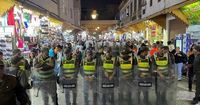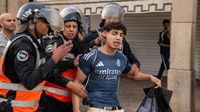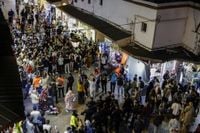For five consecutive nights, Morocco’s streets have been overtaken by a wave of youth-led protests, marking one of the largest anti-government movements the country has seen in years. What began as peaceful demonstrations against government spending priorities has spiraled into violent confrontations, mass arrests, and a national reckoning over the state of public services.
The movement, which has come to be known as the “Gen Z 212” protests, is a loosely organized, leaderless collective of mostly young Moroccans. Using platforms like TikTok, Discord, and Facebook, these tech-savvy activists have mobilized thousands to demand better healthcare, education, and employment opportunities. Their central grievance? The government’s decision to pour billions into preparations for the 2030 FIFA World Cup, even as schools and hospitals remain underfunded and in disrepair.
“The right to health, education and a dignified life is not an empty slogan but a serious demand,” the Gen Z 212 organizers declared in a statement posted on Discord, as reported by Sky News and the Associated Press. Their call for peaceful protest, however, has been repeatedly overshadowed by escalating violence, particularly in marginalized regions where anger over neglect runs deepest.
By October 1, 2025, the unrest had spread to more than a dozen cities, including the capital Rabat, Casablanca, Agadir, and Oujda near the Algerian border. According to the Moroccan Interior Ministry, 409 people had been arrested nationwide, with 263 law enforcement officers and 23 civilians injured. The toll on property was also severe: 142 police vehicles and 20 private cars were damaged, and scenes of torched cars, banks, and shops became all too common in cities like Sale, Inzegane, and Ait Amira (AP, Sky News).
In Sale, a poorer city just across the river from Rabat, an AP reporter witnessed hundreds of masked youths—mostly teenagers—setting vehicles and businesses ablaze, smashing windows, and looting, all while police were conspicuously absent. The violence was not confined to Sale. In Oujda, a protester was seriously injured after being struck by a police vehicle, an incident captured in a viral video and confirmed by both the state news agency MAP and Le Monde. The young man was hospitalized in stable condition, yet the image of a police van plowing into a demonstrator only fueled further outrage.
Protests also erupted in the southern suburbs of Agadir, where clashes saw pharmacies set on fire, cars overturned, and businesses looted. Videos circulating on social media painted a grim picture of chaos and destruction, underscoring how quickly the demonstrations had devolved from peaceful dissent to open confrontation (Le Monde).
Amid the turmoil, the Gen Z 212 collective repeatedly urged restraint. "We regret acts of rioting or vandalism that affected public or private property," the group wrote on Facebook, according to BBC News. They implored participants to remain peaceful and avoid undermining the legitimacy of their demands. Still, the anger on the streets was palpable, fueled by years of frustration over government corruption and uneven development.
Protesters’ chants and posters drew a stark contrast between Morocco’s gleaming new stadiums and the crumbling state of its hospitals and schools. One widely shared sign in Rabat read, “At least the FIFA stadium will have a first aid kit! Our hospitals don’t.” The recent deaths of eight women in a public hospital in Agadir have become a rallying cry, symbolizing the decline of the nation’s health system and the human cost of neglected public services (AP).
The government, for its part, has denied prioritizing World Cup spending over public welfare. Officials argue that many of the problems in the health sector were inherited from previous administrations. Nevertheless, the Interior Ministry warned that unauthorized demonstrations would be met with a firm response, and that anyone found breaking the law would be treated “rigorously and firmly” (Sky News).
As the protests escalated, the Moroccan Association for Human Rights (AMDH) accused security forces of assaulting demonstrators and carrying out arbitrary arrests. According to the AMDH, dozens of protesters have been detained, with 37 young people in Oujda alone released on bail pending further investigation (BBC News). Local media reported that some arrests took place while individuals were being interviewed for television, adding to the perception of a heavy-handed crackdown.
The government coalition, however, expressed a willingness to engage in dialogue. In a statement on Tuesday, it praised what it called "the balanced reaction of security authorities in line with relevant legal procedures" and said it was open to discussions with youth "within institutions and public spaces to find realistic solutions" (BBC News).
International organizations have also weighed in. Amnesty International’s regional office called on authorities to address the “legitimate demands of the youth for their social, economic, and cultural rights” and to tackle concerns about corruption. The movement has even garnered support from high-profile figures, such as Morocco’s star goalkeeper Yassine Bounou and rapper El Grande Toto, who have both voiced solidarity on social media (AP).
The timing of the unrest is significant. Morocco is set to host the Africa Cup of Nations later this year, and parliamentary elections loom in 2026. The juxtaposition of lavish sports spending with persistent poverty and regional inequities has laid bare the country’s deep divisions. Despite rapid development by some measures, many Moroccans—especially in areas far from the major cities—feel left behind and disillusioned by what they see as empty promises.
Political leaders have struggled to contain the fallout. Former prime minister Abdelilah Benkirane, now head of the opposition Islamist Justice and Development Party, called on protest organizers to end the demonstrations before they “tip over into the unknown,” but also placed blame squarely on the government for the worsening social conditions (Le Monde).
With the protests showing no sign of abating, Prime Minister Aziz Akhannouch has scheduled a government meeting to discuss healthcare and hospital reforms. Whether this will be enough to quell the anger on the streets remains to be seen. For now, Morocco stands at a crossroads, its youth demanding not just stadiums for the world to see, but schools, hospitals, and a future they can believe in.
As Morocco’s leaders weigh their next steps, the voices of its young protesters echo through the streets—insistent, unyielding, and determined to be heard.


